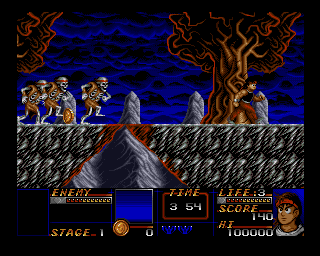Proto:Risky Woods (Amiga, DOS, Atari ST)
This page details one or more prototype versions of Risky Woods (Amiga, DOS, Atari ST).
| This page is rather stubbly and could use some expansion. Are you a bad enough dude to rescue this article? |
In 1992, Electronic Arts released a game by Zeus and Dinamic Software by the name of Risky Woods. However, an earlier version, from 1991, was found and released by cracking groups. This version, while very similar, houses quite a few gameplay-altering differences.
Contents
Cheat Keys
Like the retail version, this early version of Risky Woods has built-in cheat keys. Unlike the final version, however, these are automatically activated at game boot.
| F1 | Increase Life |
|---|---|
| F2 | Increase Coins |
| F3 | Complete Level |
Under certain circumstances, artificially ending a level while the player is immobilized will soft-lock the game at the Shoppe screen.
General Differences
- All in-game music is missing from this version. The only implemented music is on the title, game over, and high score entry screens.
| Prototype |  |
|---|---|
| Final |  |
- The status bar is significantly different from the final game, using different icons and the like.
- In the final version, Rohan's portrait changes if he gets injured or picks up an item. This doesn't happen here.
- Rohan, the player character, can only jump at one height and has no control of his movements while in mid-air.
- When damaged, Rohan always "stutters" in the opposite direction of whatever hit him, whether he's moving or not. This also happens in the final game, but if he bumps into an enemy while jumping in the final, he stutters in the direction he was going.
- In the final version, Rohan loses several coins if he dies to enemies and loses 1 weapon level if he dies or falls into a pit. Neither of these happen here.
- The camera doesn't follow Rohan, exactly, but slowly drifts toward him.
- Because of this, the camera keeps the player from moving too "quickly" through a level.
- In the prototype, there are a lot more bonus point items such as wax lips, cans of cola, packs of cigarettes, and so on.
- Coins are worth 1 in the prototype. They are worth 5 in the final.
- Eye-Keys are found intact in the prototype, while they're split into two pieces in the final.
- Eye-Keys don't destroy all enemies on the screen when used.
- Because of this, Rohan can take damage from enemies while stuck in the toss animation. He won't stutter in these instances.
- If the player misses the Eye-Key, the eye barricade doesn't teleport them back in the level.
- There are no fake monk statues in any stage. In the final game, fake monk statues will hurt the player when broken.
- Levels end very shortly after the last monk is rescued. There's a much longer delay in the final game.
- Main levels always send players to the Shoppe. In the final game, a Shoppe portal appears at the end of the stage, giving the player the option instead.
- Though there is space for boss names, they never appear in the prototype.
- Boss levels end after defeating a boss. In the final game, the player must leap down a hole instead.
- Bosses never drop coins of treasure, and boss levels skip the shop. In the final, bosses always leave coins behind and there's no way to skip going to the Shoppe.
- In the final version, getting a Game Over will prompt the player to "Play Again?" This doesn't happen here.
Title Sequence
| Prototype | Final |
|---|---|
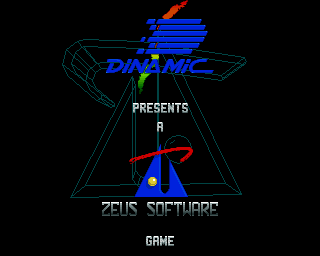 |
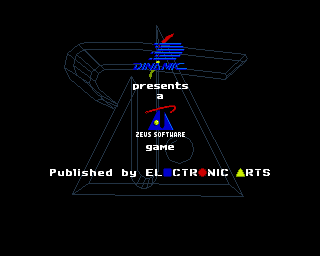 |
The company logos are bigger and the wireframe is a slightly different color. The credit to Electronic Arts is also completely missing.
| Prototype | Final |
|---|---|
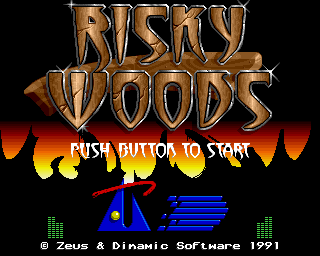 |
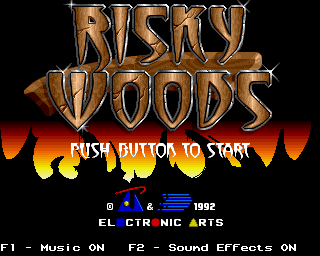 |
The prototype has a neat little audio bar display for the title music, but no visible options to disable sound or music. This could be because the game, like many Amiga games of the time, was originally built to play either sound effects or music, not both at the same time. And, again, the company logos are bigger and there's no mention of Electronic Arts.
| Prototype | Final |
|---|---|
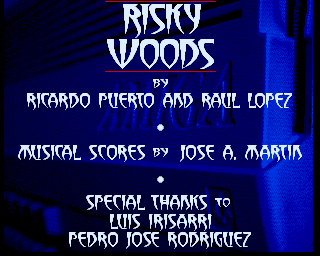 |
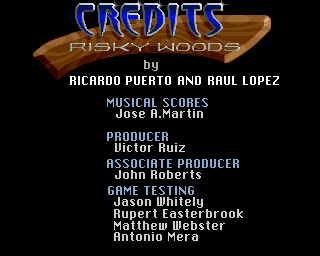 |
The credits screen is much fancier, showing an Amiga 500 computer and using the Risky Woods small font. There are significantly less people credited, as well - though curiously, neither Luis Irisarri nor Pedro Jose Rodriguez made it into the final version's credits.
Additionally, the final version uses a page header in the same style of the Ranking screen, which goes unchanged between versions.
Area 1, Mountains
| Prototype | Final |
|---|---|
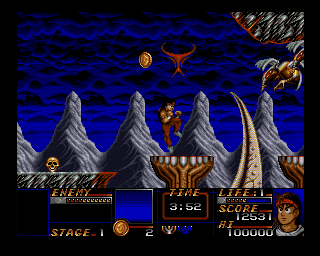 |
 |
The skewering spears in both levels changed from giant fangs to these weird, gold things decorated with human skulls. The timing on when they shoot up is a little different, too.
The rock traps react much slower in the prototype, likely due to the slow-moving camera.
Ye Olde Shoppe
| Prototype | Final |
|---|---|
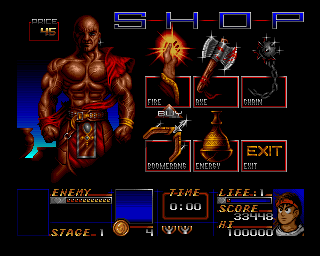 |
 |
The only major visual change to the Shoppe is the title bar, which reads "Ye Olde Shoppe" instead of simply "Shop".
As mentioned above, coins are worth 1 coin in this version. When coins quintupled in value, the prices in the Shoppe were accordingly adjusted:
| Proto | Final | |
|---|---|---|
| Fire | 45 | 70 |
| Axe | 55 | 90 |
| Chain | 40 | 60 |
| Boomerang | 65 | 160 |
| Energy | 5 | 20 |
Developer Message
At $7C in either disk is the following message:
(C) 1990 Creepsoft ltd. & DINAMIC software. coded by Pablo Ariza.
This appears to be a portion of message also found in another Dinamic Software game called A.M.C.: Astro Marine Corps. (Amiga).
The full text can also be found at the same location in the retail version.
